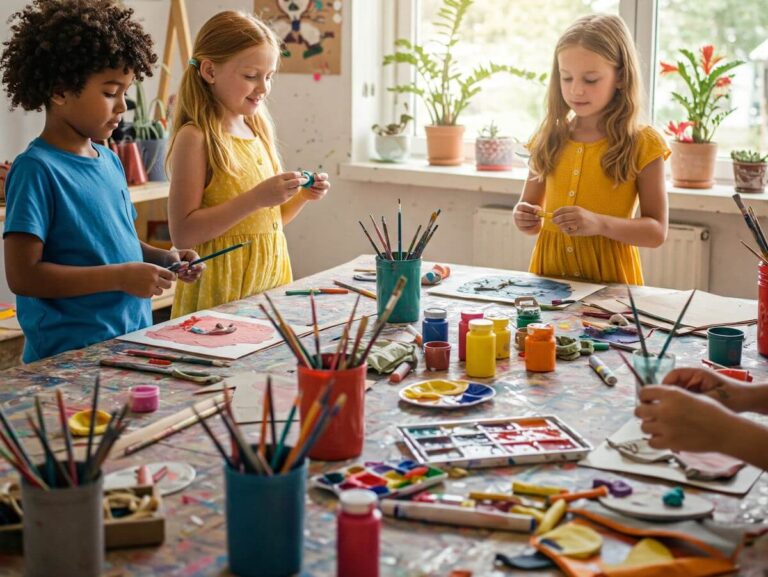Adult learners possess distinct characteristics that set them apart from younger students. Recognizing these traits is crucial for designing effective educational programs, particularly drawing classes aimed at this demographic. One notable quality of adult learners is their intrinsic motivation. They often pursue drawing not just as a hobby but as a means to fulfill personal goals or aspirations. This intrinsic motivation can be a powerful driving force, enabling them to engage deeply with the art form and persist during challenging phases of learning.
Moreover, adult learners tend to have specific learning preferences that influence how they acquire new skills. Unlike younger students who might thrive in more directive teaching methods, adults generally value collaborative approaches and active participation. They often benefit from experiential learning opportunities where they can apply techniques in real-world contexts. For drawing classes, this could translate into hands-on practice where individuals receive immediate feedback, allowing them to refine their skills progressively.
In addition to their motivation and learning preferences, adult learners frequently face unique challenges when engaging in traditional learning environments. Many adults have to balance education with personal responsibilities such as work or family commitments, which can limit their availability for scheduled classes. Furthermore, anxiety or self-doubt may hinder their confidence, particularly in subjects perceived as competitive or intimidating, such as drawing. Consequently, creating a supportive and flexible learning environment is essential to help overcome these barriers.
Ultimately, acknowledging the diverse characteristics and needs of adult learners is necessary for designing drawing classes that are not only effective but also appealing. By applying an understanding of these learners’ motivations and preferences, educators can create a nurturing and engaging atmosphere conducive to artistic development.
Creating a Welcoming Learning Environment
Establishing a supportive and inclusive atmosphere is critical for the success of drawing classes for adults. A welcoming learning environment not only engages participants but also cultivates a sense of belonging, which can significantly enhance their overall experience. To achieve this, it is essential to implement strategies that foster community and encourage creativity among all participants, regardless of their skill levels.
One effective method is to create a space that promotes interaction and collaboration. This can be done through group activities and discussions that allow learners to connect with one another. Pairing experienced artists with beginners can also provide an opportunity for mentorship, encouraging less confident participants to express themselves creatively without fear of judgment. This approach cultivates a sense of community, making it easier for learners to share ideas and techniques, subsequently boosting engagement.
Moreover, it is important to establish ground rules that prioritize respect and support within the classroom. Encouraging constructive feedback during critiques can help participants feel safe while discussing their work. All learners should be reminded that drawing is a personal journey and that each individual’s style and interpretation are equally valid. This approach ensures that no one feels out of place or discouraged, regardless of their experience level.
In addition, providing a range of materials and techniques for exploration allows participants to discover their preferences and interests without limitations. Offering various drawing mediums, such as charcoal, watercolors, or digital tools, can engage diverse learners, making the classes more appealing. Ultimately, by creating a welcoming environment that embraces creativity and inclusivity, drawing instructors can significantly enhance engagement and retention among adult learners.
Curriculum Design for Adult Drawing Classes
When designing a curriculum for adult drawing classes, it is imperative to consider the unique characteristics of adult learners. Adults typically bring a wealth of prior knowledge and experience, which can be leveraged to create a more engaging and effective learning environment. A balanced curriculum should include foundational drawing skills, yet leave room for individual expression and creative freedom. This dual focus not only builds technical competence but also nurtures artistic exploration.
To begin with, a good curriculum should introduce foundational skills such as perspective, shading, and composition. These elements form the backbone of drawing and provide a solid framework upon which learners can build their artistic abilities. However, it is essential to integrate opportunities for improvisation and personal style development within these foundational teachings. This can be achieved through open-ended assignments that encourage students to experiment with their artistic voice after mastering the basics.
In addition to structured lessons, offering flexibility in lesson plans is crucial. Adult learners often have other commitments, such as employment or family, making it important to accommodate varying schedules and learning paces. Providing options for different learning paths can help cater to the diverse needs of the participants, encouraging a self-directed approach to learning. Such flexibility could manifest through online classes, hybrid models, or varying class frequencies.
Integrating diverse artistic styles into the curriculum can also serve engagement purposes. Whether it’s realism, abstraction, or mixed media, exposure to varied techniques enriches the learning experience. This allows learners to draw inspiration from various influences, ultimately forging their own unique drawing identity. By focusing on relevance and ensuring the curriculum is learner-centered, instructors can create a thriving atmosphere for creativity and skill development.
Incorporating Technology in Drawing Classes
In today’s digital age, the integration of technology into drawing classes for adults is not only beneficial but essential for enhancing the learning experience. Various tools and platforms facilitate the delivery of online classes, ensuring that learners can access quality education from the comfort of their homes. Video conferencing platforms such as Zoom and Google Meet allow instructors to conduct live classes, enabling real-time interaction and personalized feedback. These sessions can be augmented with screen-sharing features, where teachers illustrate techniques and respond to student inquiries collectively.
Furthermore, digital sketching applications like Procreate and Adobe Fresco provide artists with versatile tools, enabling them to explore creativity without the constraints of traditional materials. These applications often feature layers and customizable brushes, which allow learners to experiment with styles and techniques that may be more challenging with physical mediums. The instant feedback that digital tools provide encourages experimentation and risk-taking, vital for artistic growth in drawing classes.
Social media platforms also play a significant role in fostering community engagement among students. Through platforms like Instagram and Facebook, learners can showcase their work, connect with peers, and engage in constructive critiques. This not only helps build a supportive community but also motivates students by exposing them to diverse artistic expressions. Engaging with online art communities and participating in challenges can inspire creativity and provide additional learning opportunities outside the formal classroom setting.
By leveraging technology in drawing classes, educators can enhance student engagement, promote collaboration, and enrich the overall learning experience. The strategic use of digital tools, online communication, and social platforms cultivates a robust educational environment where adult learners can thrive and develop their artistic skills effectively.
Effective Teaching Techniques for Adult Learners
Teaching adult learners requires a keen understanding of their unique characteristics and learning preferences. Effective instructional strategies that resonate with this demographic often center around experiential learning, peer teaching, and the provision of constructive feedback. Adult learners come with a wealth of life experiences and knowledge, and tapping into these resources can significantly enhance the learning process.
Experiential learning is one of the most effective methods for engaging adults in the classroom. This approach emphasizes hands-on experiences, where learners actively participate in the drawing process. By integrating real-world experiences, instructors can create opportunities for adult learners to apply the skills they are acquiring in class to their own projects and artistic endeavors. This not only fosters a deeper understanding of artistic techniques but also encourages creativity and self-expression.
Another valuable technique is peer teaching, which allows adult learners to share their expertise with one another. This collaborative approach encourages a sense of community within the classroom, fostering relationships that can enhance the learning experience. By creating small groups where students can work together, learners can provide feedback to each other, offering diverse perspectives and insights that they may not have considered on their own. Peer teaching also empowers students to take ownership of their learning, motivating them to engage more actively in their artistic development.
Constructive feedback plays an essential role in the learning journey of adult students. Providing specific, actionable feedback enables learners to identify their strengths and areas for improvement. It encourages a growth mindset and motivates them to implement changes in their work. Moreover, promoting an environment where feedback is a two-way street—where adults feel comfortable discussing their thoughts and receiving input—fosters a richer learning experience. This collaborative atmosphere not only enhances skill acquisition but also nurtures a lifelong passion for learning.
Marketing Your Drawing Classes
To successfully attract adult learners to your drawing classes, it is crucial to implement a comprehensive marketing strategy. The first step in this process is identifying your target audience. Adult learners may encompass a wide range of individuals, including professionals looking for a creative outlet, retirees seeking a new hobby, or students preparing for a career in art. By understanding the demographics and preferences of your potential students, you can tailor your marketing messages to resonate more effectively with these groups.
Utilizing social media platforms is an essential aspect of modern marketing. Websites such as Instagram, Facebook, and Pinterest provide visual showcases of artwork and allow you to engage directly with your audience. Regularly sharing sample artworks, behind-the-scenes footage of classes, and testimonials from previous students can enhance your online presence. Consider creating dedicated hashtags related to your drawing classes, which can increase visibility and attract followers interested in artistic pursuits.
Crafting engaging promotional material is another vital component of your marketing strategy. Brochures, flyers, and digital advertisements should highlight the unique aspects of your drawing classes, including the curriculum, class schedule, and instructor credentials. Clear, concise information combined with appealing visuals can draw in potential students. It is also beneficial to create limited-time offers or discounts, which can motivate individuals to enroll in your classes.
Finally, leveraging partnerships with local community organizations can significantly boost awareness of your offerings. Collaborate with art supply stores, community centers, and libraries to promote your drawing classes through their networks. Organizing workshops or free trial sessions in partnership with these entities can also attract participants and showcase the value you provide as an instructor.
Building a Community Among Learners
Creating a sense of community within drawing classes for adults can significantly enhance the learning experience. When individuals feel connected to their peers, they are more likely to engage actively and invest in their artistic journey. To foster this environment, several strategies can be implemented. One effective approach is organizing group projects that encourage collaboration among learners. By collaborating on a project, participants not only develop their technical skills but also build relationships, as they share ideas and support one another throughout the creative process.
Facilitating peer reviews is another method that can strengthen community ties. In these sessions, participants can provide constructive feedback on each other’s artwork, fostering an atmosphere of mutual respect and support. This feedback loop allows learners to see different perspectives on their work, enhancing their artistic growth while also promoting a spirit of camaraderie. Encouraging open discussions during these reviews can encourage participants to express their thoughts and feelings, further solidifying their connections with one another.
Hosting showcases for student work also plays a critical role in community building. By providing a platform for learners to display their artwork, participants can celebrate each other’s accomplishments and gain exposure to diverse styles and techniques. This not only boosts individual confidence but also reinforces the bonds formed through shared experiences. Additionally, creating dedicated online platforms for ongoing discussions enables learners to maintain connections and continue sharing ideas beyond the physical classroom. These platforms can serve as spaces for providing updates, sharing resources, and discussing techniques, ensuring that the community thrives even after formal classes have concluded.
Through these strategies, drawing classes can effectively cultivate a supportive learning environment where individuals feel valued and connected, ultimately enriching their artistic exploration.
Feedback and Improvement: A Continuous Process
In the realm of drawing classes for adults, fostering an environment that prioritizes feedback is essential for ongoing improvement and learner satisfaction. Continuous feedback not only helps instructors refine their teaching methods but also ensures that the classes meet the evolving needs of participants. Engaging with learners to gather their insights can significantly enhance the overall experience.
One effective method for collecting feedback is through structured surveys. These surveys can be distributed at the end of each session or at regular intervals throughout the course. Questions should be designed to gauge various aspects of the class, including the curriculum’s relevance, the instructor’s effectiveness, and the overall learning environment. In addition to quantitative questions, open-ended questions that allow learners to express their thoughts freely can yield valuable qualitative data. This dual approach facilitates a comprehensive understanding of learners’ perspectives and preferences.
Informal discussions also play a crucial role in feedback gathering. Encouraging an open dialogue among participants during or after classes fosters a sense of community and openness. Instructors can take advantage of moments during breaks or wrap-up sessions to invite thoughts on class content, teaching styles, or suggestions for improvement. Such interactions can provide immediate and actionable insights that may not be captured through traditional survey methods.
Implementing changes based on collected feedback should be done thoughtfully and strategically. Prioritizing which areas to address first can ensure that the modifications align with current learner expectations and enhance engagement effectively. By communicating how feedback has been acted upon, instructors can demonstrate their commitment to improvement, thereby increasing trust and satisfaction among learners.
Ultimately, establishing a robust feedback loop is not merely an accessory to the drawing classes for adults; it is a vital component that drives quality enhancement and fosters an engaging learning environment. Continually seeking input and adjusting accordingly will always be beneficial for both instructors and participants alike.
Highlighting Success Stories: Inspiring Learners
The transformative power of drawing classes for adults is best illustrated through the success stories of individuals who have embraced their artistic journey. Many students come to drawing classes seeking a creative outlet, a new hobby, or even a fresh career path. Their experiences not only highlight the tangible benefits of engaging with art but also demonstrate how drawing fosters personal growth and confidence.
Take, for instance, the story of Mark, a 45-year-old engineer who enrolled in a local drawing class to find a means of relaxation and escape from his demanding job. Initially hesitant, Mark discovered a profound joy in recreating the world around him on paper. His newfound passion ignited a creative spark, leading him to explore other forms of art and even display his works in community exhibitions. Mark’s journey illustrates how engaging in drawing classes can lead to unexpected opportunities and personal fulfillment.
Similarly, consider Angela, a retired teacher who turned to drawing classes to combat feelings of isolation after leaving the workforce. Through her weekly classes, Angela not only honed her drawing skills but also formed lasting friendships with her classmates. The social aspect of these classes played a significant role in revitalizing her sense of community and purpose. Angela’s story exemplifies the importance of drawing as a tool for connection and emotional well-being.
Furthermore, the experiences of these individuals have inspired others in their communities to pursue drawing, showcasing that art is not just an individual endeavor. The passion and enthusiasm they have cultivated resonate, promoting a culture of creativity among peers. These success stories serve as potent reminders of the joys and benefits that drawing classes can offer, encouraging potential learners to take the first step on their own artistic journeys.




